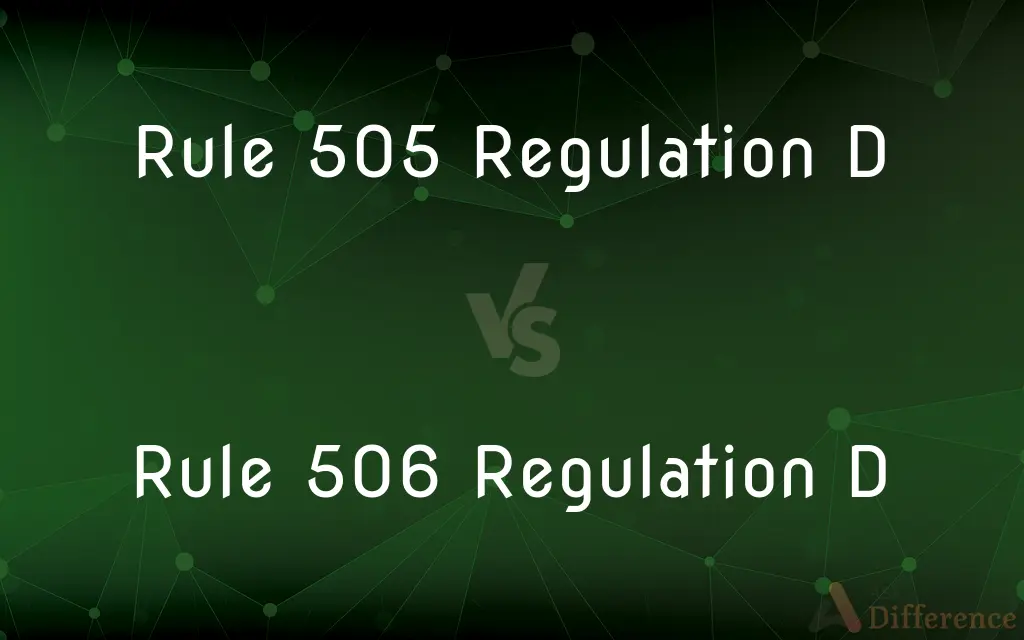Rule 505 Regulation D vs. Rule 506 Regulation D — What's the Difference?
By Tayyaba Rehman & Urooj Arif — Published on February 13, 2024
Rule 505 Regulation D allows up to $5M in securities sales to an unlimited number of accredited investors, while Rule 506 Regulation D permits unlimited funds from accredited investors with no cap.

Difference Between Rule 505 Regulation D and Rule 506 Regulation D
Table of Contents
ADVERTISEMENT
Key Differences
Rule 505 Regulation D and Rule 506 Regulation D are both part of Regulation D under the Securities Act of 1933, aimed at providing exemptions for private companies from registering their securities offerings. Rule 505 Regulation D permits the sale of up to $5 million of securities in any 12-month period to an unlimited number of accredited investors and up to 35 non-accredited investors. Rule 506 Regulation D, on the other hand, allows companies to raise an unlimited amount of money but primarily from accredited investors, with no explicit cap on the investment amount.
The primary difference between Rule 505 Regulation D and Rule 506 Regulation D lies in the scale and scope of the fundraising. Rule 505 Regulation D is designed for smaller offerings, capped at $5 million, making it suitable for small to medium-sized enterprises looking to raise capital without going public. Rule 506 Regulation D is tailored for potentially larger offerings, with no upper limit on the amount that can be raised, providing a more flexible option for companies with larger funding needs.
Another notable distinction is in the investor composition and disclosure requirements. Under Rule 505 Regulation D, companies can include up to 35 non-accredited investors, but this comes with the necessity of providing additional disclosures, similar to those required in public offerings. Rule 506 Regulation D, especially under its 506(b) variant, imposes no such requirement, although it restricts solicitation and advertising of the offering.
Both Rule 505 Regulation D and Rule 506 Regulation D serve to facilitate capital formation for private companies while offering protection to investors through disclosure requirements and investment limits. However, Rule 506 Regulation D, with its more lenient caps and broader appeal to accredited investors, has become a more popular route for companies looking to raise funds without the burdens of a full public offering.
In summary, while both Rule 505 Regulation D and Rule 506 Regulation D provide valuable exemptions for securities offerings, they cater to different scales of operations and investor bases. Companies must carefully consider their capital needs, investor base, and regulatory obligations when choosing between these two regulatory pathways.
ADVERTISEMENT
Comparison Chart
Capital Raise Limit
Up to $5 million in a 12-month period
No limit on the amount that can be raised
Accredited Investors
Unlimited number allowed
Unlimited number allowed
Non-Accredited Investors
Up to 35 non-accredited investors
Generally not allowed in 506(c)
Disclosure Requirements
More rigorous for non-accredited investors
Less rigorous, primarily aimed at accredited investors
General Solicitation
Not allowed
Allowed under 506(c) with certain conditions
Compare with Definitions
Rule 505 Regulation D
This rule is ideal for smaller private offerings and startups.
Rule 505 Regulation D was the perfect fit for our boutique tech firm's capital needs.
Rule 506 Regulation D
Rule 506(b) prohibits general solicitation, whereas 506(c) allows it under conditions.
Under Rule 506(c) Regulation D, we could openly advertise our investment opportunity.
Rule 505 Regulation D
Rule 505 offerings are subject to state securities laws.
Navigating state laws was crucial for our Rule 505 Regulation D offering.
Rule 506 Regulation D
Provides a safe harbor under Regulation D for compliance with the Securities Act.
Our legal team ensured our Rule 506 Regulation D offering was within the safe harbor provisions.
Rule 505 Regulation D
It permits sales to both accredited and up to 35 non-accredited investors.
We utilized Rule 505 Regulation D to include small investors in our funding round.
Rule 506 Regulation D
Rule 506 Regulation D allows unlimited fundraising from accredited investors without SEC registration.
Our expansion was funded entirely through a Rule 506 Regulation D exemption.
Rule 505 Regulation D
Rule 505 mandates significant disclosures for non-accredited investors.
Due to Rule 505 Regulation D, we prepared extensive financial documents for our non-accredited backers.
Rule 506 Regulation D
Investments can come from an unlimited number of accredited investors and up to 35 sophisticated ones.
Leveraging Rule 506 Regulation D, we welcomed numerous high-net-worth individuals to invest.
Rule 505 Regulation D
Rule 505 Regulation D allows companies to raise up to $5M from investors without public registration.
Our startup raised $4M under Rule 505 Regulation D last year.
Rule 506 Regulation D
It is often used for larger private placements due to no cap on raising amounts.
We opted for Rule 506 Regulation D to support our multimillion-dollar development project.
Common Curiosities
What is Rule 506 Regulation D?
This regulation permits companies to raise unlimited funds primarily from accredited investors with fewer restrictions compared to Rule 505.
Can Rule 506 Regulation D offerings involve non-accredited investors?
Yes, but under 506(b), and they must be sophisticated investors with a pre-existing relationship with the issuer.
Can companies advertise their offerings under Rule 506 Regulation D?
Yes, but only under Rule 506(c), and all investors must be verified as accredited.
Is Rule 505 Regulation D subject to state securities laws?
Yes, offerings under Rule 505 must comply with state securities regulations, which can vary widely.
How many non-accredited investors can participate in Rule 505 offerings?
Up to 35 non-accredited investors can partake in Rule 505 Regulation D offerings.
What is Rule 505 Regulation D?
It's a SEC regulation allowing private companies to raise up to $5M from accredited and limited non-accredited investors without public registration.
What are the risks involved in participating in a Rule 505 or Rule 506 offering?
Investors face the risk of limited liquidity, less regulatory protection, and the potential for loss of their investment.
Can international investors participate in Rule 505 or Rule 506 offerings?
Yes, but the offerings must comply with the securities laws of the investors' home countries as well.
Can Rule 506 Regulation D be used for any type of securities?
Yes, Rule 506 Regulation D can be applied to various securities, including stocks, bonds, and more, without restrictions on the type.
Are there capital raise limits under Rule 506 Regulation D?
No, Rule 506 Regulation D does not impose a cap on the amount that can be raised.
What happens if a company exceeds the $5M limit under Rule 505 Regulation D?
Exceeding the limit may disqualify the offering from Rule 505 exemption, subjecting it to SEC registration requirements.
Do Rule 505 Regulation D offerings require disclosures to non-accredited investors?
Yes, companies must provide significant disclosures, similar to those in public offerings, to non-accredited investors under Rule 505.
What are the primary benefits of using Rule 506 Regulation D?
It offers flexibility in raising capital without a cap, primarily from accredited investors, with less stringent disclosure requirements.
How do Rule 505 and Rule 506 offerings differ in terms of investor qualifications?
Rule 505 allows for a mix of accredited and non-accredited investors, while Rule 506 is more restrictive, focusing mainly on accredited investors.
How does Rule 505 Regulation D impact small businesses?
It provides a pathway for small businesses to access capital from a broader range of investors without undergoing a public offering.
Share Your Discovery

Previous Comparison
Valentine’s Day vs. White Day
Next Comparison
EAD vs. H-1BAuthor Spotlight
Written by
Tayyaba RehmanTayyaba Rehman is a distinguished writer, currently serving as a primary contributor to askdifference.com. As a researcher in semantics and etymology, Tayyaba's passion for the complexity of languages and their distinctions has found a perfect home on the platform. Tayyaba delves into the intricacies of language, distinguishing between commonly confused words and phrases, thereby providing clarity for readers worldwide.
Co-written by
Urooj ArifUrooj is a skilled content writer at Ask Difference, known for her exceptional ability to simplify complex topics into engaging and informative content. With a passion for research and a flair for clear, concise writing, she consistently delivers articles that resonate with our diverse audience.













































